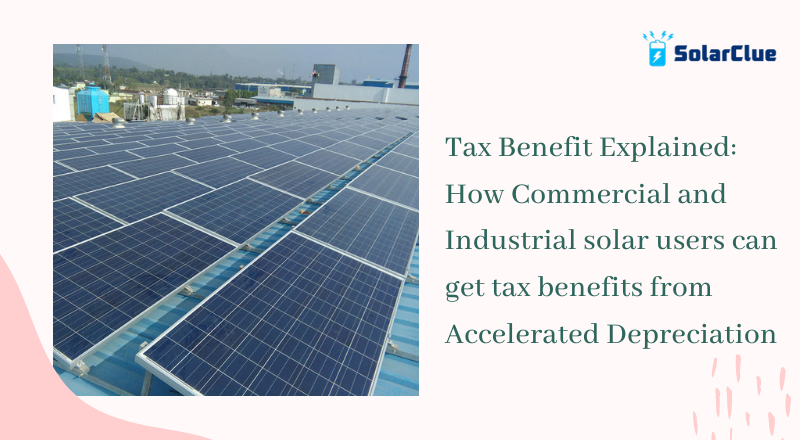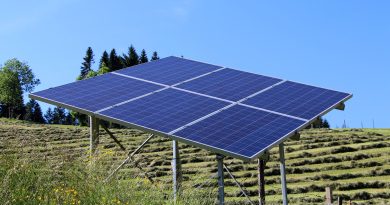Tax Benefit Explained: How Commercial and Industrial solar users can get tax benefits from Accelerated Depreciation
It’s a fact that the accelerated depreciation benefit permits the commercial and industrial solar power users in India to depreciate their investment in solar panels or solar power plants at a much higher rate than general fixed assets. This in return, allows the users to claim their tax benefits on the value run down in a given year. Tax incentives for commercial and industrial solar users are offered by the government of India.
The government of India offers accelerated depreciation of fixed assets equated with the solar power plant to promote the use of solar power in the commercial and industrial sectors. According to statistics, the Government of India to reach 175GW of green energy capacity by 2022, has shown a keen interest in endorsing the use of green energy. Therefore, the use of solar panels through different programs (Rooftop Solar Program for residential, commercial, and industrial buildings) is encouraged by the department of The Ministry of New and Renewable Energy.
The term Accelerated Depreciation is very common when it comes to solar power investments. So, let’s understand what Accelerated Depreciation is. It is a method of depreciation wherein the value of the solar plant (your fixed asset) reduces at a faster rate in the early years – thus, the depreciation is accelerated. In other words, Accelerated Depreciation is described as a fast rate of depreciation of the fixed assets, in the earlier years of assets. In Accelerated Depreciation, both earnings and assets will be decreased in the early years due to higher depreciation expense. But, due to lower depreciation, there will be a minimal impact on earnings and assets in the later years.
Now another question arises, how does it benefit those who are investing in solar?
It is beneficial in reducing the corporate taxable income during the early years especially the first 2 or 3 years of the solar power project and thus, can be considered to deliver cash profits during these years. For example, a commercial or industrial user, suppose falls under an income tax bracket of 25% or as per the current tax bracket in India given by The Income Tax Act, 1961. Now let’s say this particular user builds a Solar asset that is valued at Rs. 1 Crore in a given financial year, with an expected asset life of 20 yrs. The user will be able to claim an annual depreciation of 40% of Rs. 1.0 Crore (considering written down value method (WDV) depreciation) under normal circumstances for purpose of income tax. This implies that the user will be able to claim a tax benefit of 40% for Rs. 1.0 Crore = Rs. 40 Lakh for the 1st year, 40% of Rs. 60 lakh ( 1 cr-40 lakh)= 24 Lakh for the next year, 40% of Rs. 36 lakh ( 60 lakh-24lakh)= 14.4 Lakh for the next year and so on until the life of the asset. Mostly, the importance of ‘accelerated depreciation’ in the context of the solar industry can be considered:
- Incentivizes investment in solar.
- Accelerates profit-making by reducing the taxable income in the early years.
- Postpone higher taxes to a later period in time.
Accordingly, WDV and Depreciation for all years is as below:
| Years | WDV at beginning ( ₹ in lakhs) | Depreciation ( ₹ in lakhs) | WDV at end ( ₹ in lakhs) |
| 0 | ₹ 100.00 | ₹ 0.00 | ₹ 100.00 |
| 1 | ₹ 100.00 | ₹ 40.00 | ₹ 60.00 |
| 2 | ₹ 60.00 | ₹ 24.00 | ₹ 36.00 |
| 3 | ₹ 36.00 | ₹ 14.40 | ₹ 21.60 |
| 4 | ₹ 21.60 | ₹ 8.64 | ₹ 12.96 |
| 5 | ₹ 12.96 | ₹ 5.18 | ₹ 7.78 |
| 6 | ₹ 7.78 | ₹ 3.11 | ₹ 4.67 |
| 7 | ₹ 4.67 | ₹ 1.87 | ₹ 2.80 |
| 8 | ₹ 2.80 | ₹ 1.12 | ₹ 1.68 |
| 9 | ₹ 1.68 | ₹ 0.67 | ₹ 1.01 |
| 10 | ₹ 1.01 | ₹ 0.40 | ₹ 0.60 |
| 11 | ₹ 0.60 | ₹ 0.24 | ₹ 0.36 |
| 12 | ₹ 0.36 | ₹ 0.15 | ₹ 0.22 |
| 13 | ₹ 0.22 | ₹ 0.09 | ₹ 0.13 |
| 14 | ₹ 0.13 | ₹ 0.05 | ₹ 0.08 |
| 15 | ₹ 0.08 | ₹ 0.03 | ₹ 0.05 |
| 16 | ₹ 0.05 | ₹ 0.02 | ₹ 0.03 |
| 17 | ₹ 0.03 | ₹ 0.01 | ₹ 0.02 |
| 18 | ₹ 0.02 | ₹ 0.01 | ₹ 0.01 |
| 19 | ₹ 0.01 | ₹ 0.00 | ₹ 0.01 |
| 20 | ₹ 0.01 | ₹ 0.00 | ₹ 0.00 |
The accelerated depreciation benefits the commercial and industrial solar user to get tax relief – Under section 32 of the Income Tax Act. The current rate of acceleration is 40% that can be claimed in one year, and it indicates that the commercial and industrial solar rooftop users can get benefit from the government’s tax rebates on accelerated depreciation of 40%.
Further, one more question arises, why it (accelerated depreciation) does not apply to all anyone investing in solar? Firstly, as a financial incentive, accelerated depreciation is only applicable to business entities; if you are running a business, accelerated depreciation is a benefit only if you are a profit-making company. The reason is clear – unless you are making profits, then you are not paying taxes, and accelerated depreciation essentially is a benefit you get through the lowering of your taxes. If you are not any way of paying taxes, then the financial difference cannot accelerate, which makes depreciation. Thus, residential solar energy investors cannot benefit from accelerated depreciation.
Last Word
A lot of corporates have moved from conventional resources to renewable resources in recent years and solar energy is one of them. Switching to renewable energy is the best thing and there are many reasons to do that. Few of them are as follows:
- Its sustainability is infinite, and hence, we will never run out of it.
- Generating energy in an eco-friendly manner without the emission of greenhouse gas as in the case of fossil fuel, thus, reducing air pollution.
- Expanding energy supply and reducing dependence on imported fuels.
- Making economic development and jobs in manufacturing, installation, and operation & management, etc.




I have recently started a website, the information you provide on this website has helped me greatly. Thanks for all of your time & work. Tedda Bourke Latreece
Hello,
Thanks for your appreciation and showing interest towards our website.
Yes! Finally someone writes about cheap essay writing service
usa.
https://www.damondnollan.com/p/contact-me.html?showComment=1611301621066
Cusomized Comlosing Providers
write papers for me
write papers for me https://hub.docker.com/r/celitime1978/edusson_review
Hello,
Thanks for your appreciation.
Ujjwala solar panel cam get subcidy or tax benefit to customer how many and how much can get benefit get.